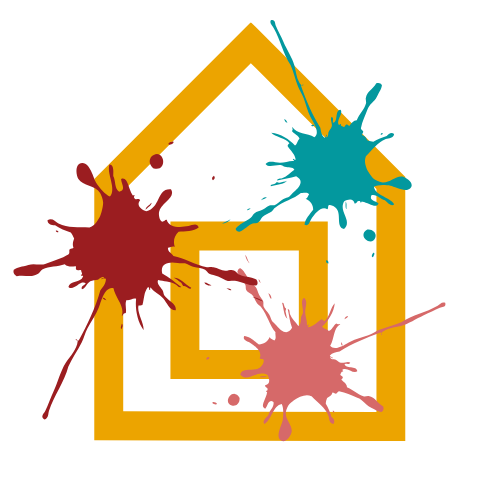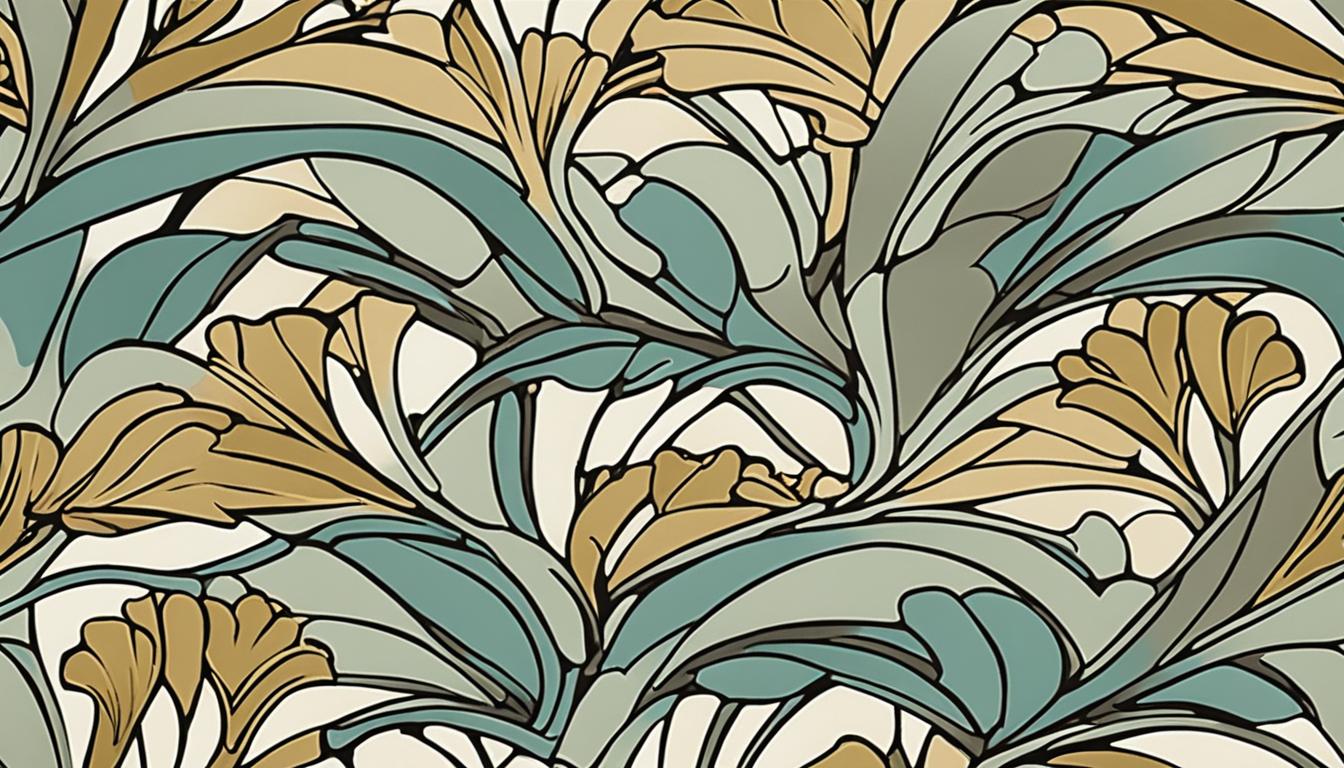Welcome to our in-depth exploration of the captivating world of Art Nouveau decor. In this article, we dive into the intricacies of this renowned design style that emerged in Europe during the late 19th and early 20th centuries. From its origins to its enduring appeal, we unravel the essence of Art Nouveau, delving into its characteristics, artists, architecture, and interior design.
Art Nouveau is more than just a style; it’s an expression that blurs the lines between fine arts and decorative arts, seamlessly blending them into all facets of daily life. From the grandeur of architectural masterpieces to the intimate details of furniture and fixtures, Art Nouveau exudes an elegance that is truly timeless.
What sets Art Nouveau apart is its philosophy, which cherishes the beauty of nature and its harmonious integration into design. Through organic forms, sinuous lines, and intricate details, Art Nouveau captures the essence of the natural world, creating spaces that exude comfort, aesthetic pleasure, and a unique charm.
The color palette of Art Nouveau draws inspiration directly from nature, with soft and muted tones as the backdrop, punctuated by bold accents that evoke the vibrant hues found in flora and fauna. The materials used in Art Nouveau design are equally diverse, ranging from wood and glass to wrought iron and ceramics, all adding texture and visual interest to the space.
When it comes to furniture and fixtures, Art Nouveau showcases sinuous lines, organic shapes, and intricate craftsmanship. Every piece is carefully designed to harmonize aesthetics with functionality, seamlessly integrating into the overall Art Nouveau ambiance. Accessories and decor play a significant role in complementing the Art Nouveau interiors, showcasing organic shapes, intricate patterns, and natural-inspired motifs.
Join us on this Art Nouveau journey as we explore the historical origins, design philosophy, color palette, materials, furniture, fixtures, accessories, and the enduring popularity of this elegant and captivating design style.
Art Nouveau decor encapsulates the perfect balance of nature, harmony, and enduring elegance, crafting spaces that embody the beauty of the organic world. Stay tuned as we delve into the rich history and the unique design elements that define this timeless style.
The Origins of Art Nouveau Design
Art Nouveau design emerged in Europe as a reaction against the industrial revolution’s mechanistic influence on the art world. It sought to break free from the monotony of mass production and bring art into every aspect of life, including architecture and interior design. The movement quickly gained popularity and spread across Europe and the United States, leaving a significant impact on the design landscape.
Art Nouveau design was a direct response to the rapidly changing society during the late 19th and early 20th centuries. It was a rebellion against the industrial revolution and the dehumanizing effects it had on the arts. Artists and designers sought to create a new aesthetic that celebrated beauty, craftsmanship, and natural forms.
One of the major influences on the emergence of Art Nouveau design was the Arts and Crafts movement in Britain. Led by figures such as William Morris, the Arts and Crafts movement advocated for a return to handmade and artisanal creations, promoting a sense of individuality and uniqueness in design.
European artists and architects, such as Hector Guimard in France and Antoni Gaudí in Spain, played a pivotal role in shaping the Art Nouveau movement. Their innovative designs and use of organic forms and flowing lines became iconic symbols of the style.
Art Nouveau design was not limited to one particular country or region. It found expression in various forms throughout Europe, including Belgium, Austria, Scotland, and Germany. In the United States, the movement was embraced by notable architects such as Louis Sullivan and Frank Lloyd Wright.
The blending of fine arts and decorative arts was a central tenet of Art Nouveau design. The movement aimed to blur the boundaries between these two disciplines, creating a cohesive and harmonious aesthetic that integrated art into everyday life.
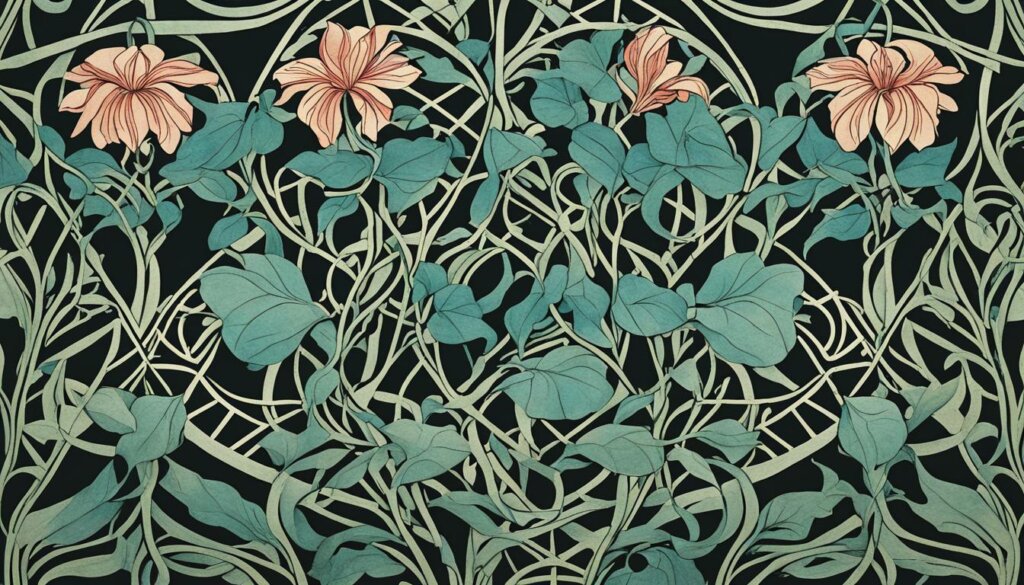
Art Nouveau design continues to inspire and influence contemporary designers and artists. Its emphasis on organic forms, intricate details, and a celebration of nature resonates with those seeking a harmonious blend of aesthetics and functionality. By understanding the origins of Art Nouveau, we can appreciate the enduring legacy of this influential design movement.
Design Philosophy of Art Nouveau
At its core, Art Nouveau design cherishes the beauty of nature. We believe that nature holds the key to extraordinary aesthetics, inspiring us with its organic forms, flowing lines, and intricate details. In our pursuit of creating harmonious environments, Art Nouveau design aims to echo the natural elements that surround us. By incorporating the essence of nature into our spaces, we seek to promote not only aesthetic pleasure but also a sense of comfort and tranquility.
Art Nouveau design places a strong emphasis on craftsmanship and the value of handmade items. We celebrate the artistry and skill behind each piece, valuing the unique charm and elegance that comes with handcrafted goods. This focus on handmade items sets Art Nouveau apart from the mass-produced goods of the industrial era, offering a sense of authenticity and individuality to our spaces.
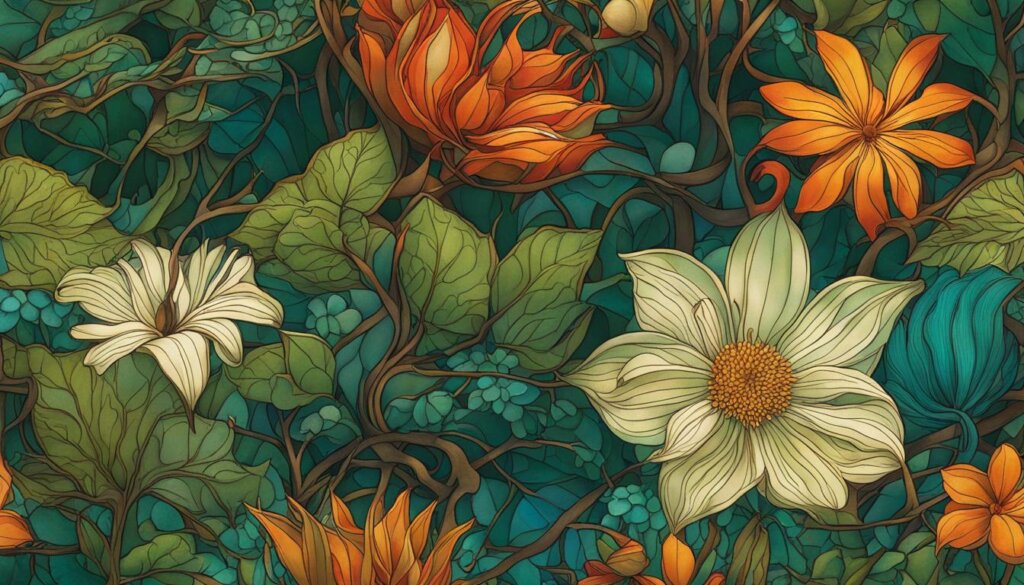
Through Art Nouveau design, we invite you to experience the unique charm and elegance that can only be found in the beauty of nature translated into intricate designs and flowing lines. Our spaces are a testament to the craftsmanship and attention to detail that bring organic forms to life. Join us as we immerse ourselves in the allure of Art Nouveau design and discover the extraordinary beauty that lies within.
Colors in Art Nouveau Design
Art Nouveau design draws its color palette from the beauty of nature. Soft tones and muted shades dominate, evoking the subtle hues found in flora and fauna. Olive green, mustard yellow, and peacock blue are common examples of these tranquil colors. However, to create a dynamic contrast and enhance the visual appeal of Art Nouveau interiors, bold and dramatic accents like ruby red or deep violet are often incorporated.
The color choices in Art Nouveau design aim to create a soothing and inviting atmosphere. The harmonious blend of natural and rich colors resonates with the movement’s organic philosophy, fostering a sense of tranquility and aesthetic pleasure.
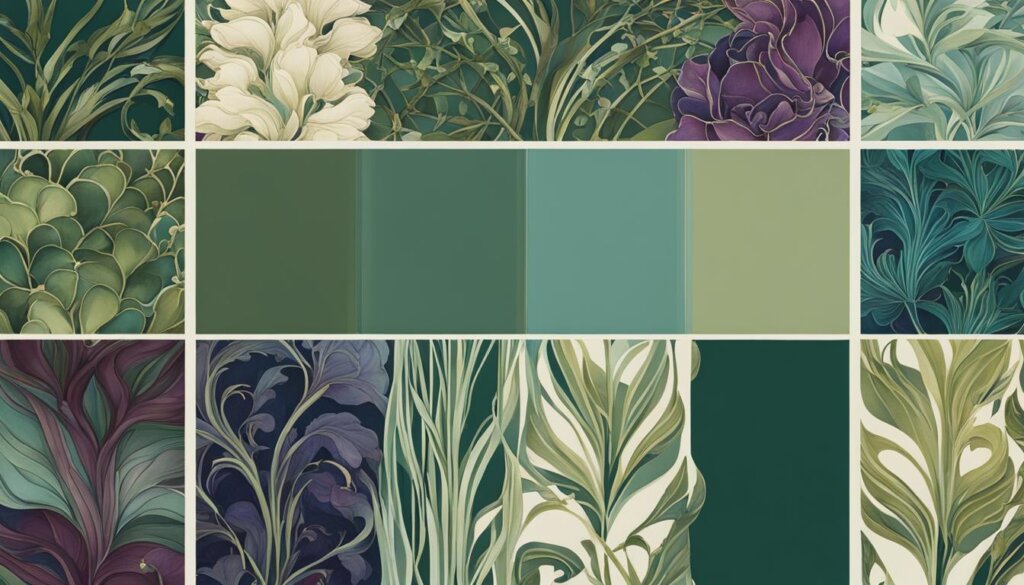
Soft tones and muted shades
- Olive green
- Mustard yellow
- Peacock blue
Bold and dramatic accents
- Ruby red
- Deep violet
Materials in Art Nouveau Design
Art Nouveau design is known for its extensive use of diverse materials, both natural and man-made, which reflects the movement’s strong connection to nature and its emphasis on craftsmanship. The choice of materials in Art Nouveau interiors plays a crucial role in creating a harmonious and visually captivating space.
One of the most commonly used materials in Art Nouveau design is wood. Its warm and natural qualities bring a sense of organic beauty to the interior. Art Nouveau furniture often showcases intricate woodwork, featuring flowing lines and decorative carvings that add a touch of elegance and charm.
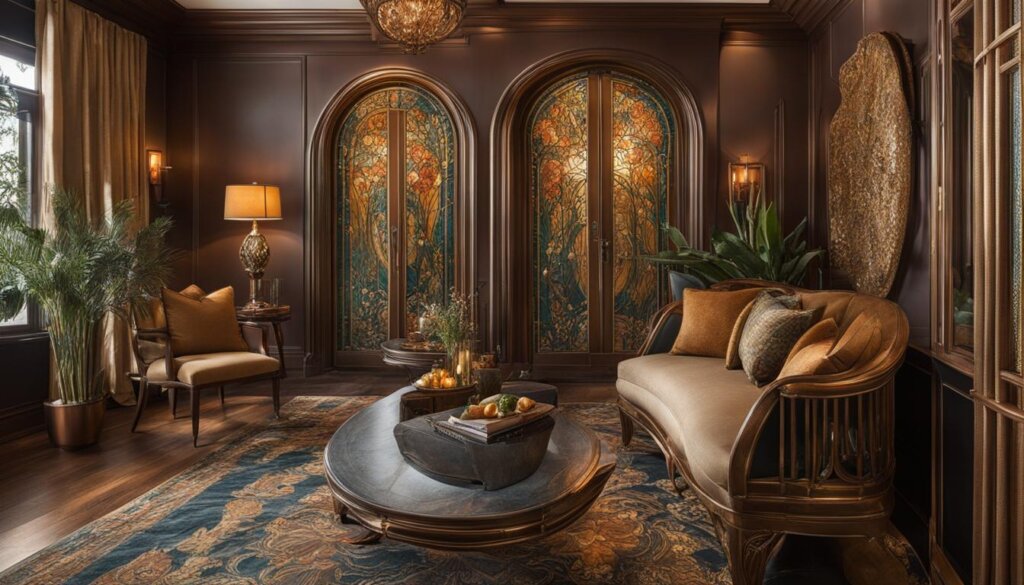
Glass is another prominent material in Art Nouveau design. It is often employed to create delicate and ornate elements, such as stained glass windows, decorative panels, and light fixtures. The interplay of colored and textured glass adds depth and visual interest to the space, casting unique patterns and colors when illuminated.
Wrought iron is frequently used in Art Nouveau design for its versatility and ability to achieve intricate and flowing forms. It is commonly found in decorative elements such as railings, room dividers, and lighting fixtures. The malleability of wrought iron allows for the creation of stunning organic shapes and curvilinear patterns that enhance the overall aesthetic and sense of craftsmanship.
Ceramics also play a significant role in Art Nouveau interiors. From intricately designed tiles to ceramic sculptures and vases, this material adds texture and visual interest to the space. The use of ceramics in Art Nouveau design emphasizes the movement’s commitment to handmade craftsmanship and its appreciation for the beauty of natural forms.
Textiles are another essential element in Art Nouveau design, contributing to the overall ambiance and comfort of the space. Soft and luxurious fabrics, such as velvet, silk, and lace, are often used for upholstery, curtains, and decorative draperies. These textiles enhance the tactile experience, adding a layer of sophistication and elegance to the interior.
Lastly, stained glass is a highly distinctive material in Art Nouveau design. With its vibrant colors and intricate patterns, stained glass windows and panels create a mesmerizing play of light and shadow. These pieces often feature nature-inspired motifs, such as flowers, foliage, and animals, further reinforcing the connection to the natural world.
By incorporating a rich variety of materials, Art Nouveau design achieves both texture and visual interest, creating stunning interiors that celebrate nature and showcase the masterful craftsmanship of the era.
Furniture and Fixtures in Art Nouveau Design
In Art Nouveau design, furniture and fixtures serve as prominent expressions of the movement’s aesthetic principles and craftsmanship. These pieces often feature sinuous lines, organic shapes, and intricate detailing, showcasing the influence of nature on the design.
The furniture in Art Nouveau interiors is not only visually stunning but also functional, designed with comfort and aesthetics in mind. Ergonomically shaped seating provides both support and style, allowing occupants to indulge in utmost relaxation. The fluid forms of storage solutions seamlessly blend with the overall design, offering practicality without compromising on visual appeal.
One of the defining characteristics of Art Nouveau furniture is its emphasis on organic forms and ornamentation. Flowing lines, inspired by the curvaceousness of nature, adorn chairs, tables, and cabinets, creating a sense of movement and harmony. Floral motifs and stylized natural elements, like leaves, vines, or branches, are intricately incorporated into the furniture, further enhancing its charm and evoking the beauty of the natural world.
Craftsmanship plays a crucial role in the creation of Art Nouveau furniture and fixtures. Skilled artisans meticulously carve, shape, and assemble each piece, paying meticulous attention to detail and achieving a level of artistry that is rarely seen in mass-produced items. This commitment to craftsmanship ensures that every furniture and fixture in Art Nouveau design is not only visually appealing but also built to last, standing as a testament to the movement’s enduring legacy.
Accessories and Décor in Art Nouveau Design
To complement the elegant furniture and fixtures, Art Nouveau spaces often feature carefully chosen accessories and décor items. These items showcase organic shapes, intricate patterns, and natural-inspired motifs, enhancing the overall design aesthetic.
Artwork and wall décor play a significant role in Art Nouveau interiors, adding visual interest and reinforcing the connection to nature. Paintings, tapestries, and posters featuring floral and botanical themes are commonly found, bringing the beauty of the outdoors inside. The intricate patterns and vibrant colors in these artworks contribute to the overall ambiance of the space.
Lighting fixtures are another key element of Art Nouveau design. Chandeliers, sconces, and table lamps often feature organic shapes and incorporate glass accents. These fixtures provide both functional lighting and artistic focal points, shining a warm and inviting glow throughout the room.
Art Nouveau decorative objects, such as vases, sculptures, and mirrors, are carefully selected to enhance the style’s organic forms and intricate detailing. Vases adorned with flowing lines and natural motifs can serve as striking centerpieces, while sculptures portraying graceful figures or stylized nature elements add beauty and creativity to the space. Mirrors with ornate frames featuring curvilinear patterns can reflect light and create a sense of depth and elegance.
Overall, Art Nouveau accessories and décor contribute to the cohesive and harmonious nature of the design style, celebrating the beauty of nature and adding a touch of artistry to every corner of the space.
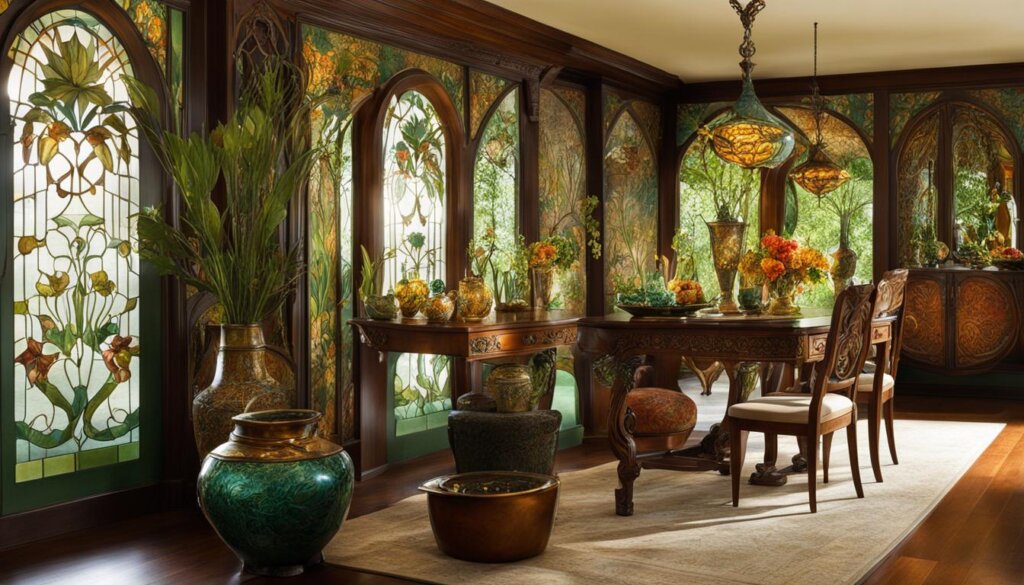
Popularity and Enduring Appeal of Art Nouveau Design
The enduring popularity of Art Nouveau design can be attributed to its versatility, timelessness, and focus on nature. Art Nouveau offers a visually appealing aesthetic that appeals to a wide range of tastes. Whether you prefer a modern, minimalist style or a more traditional, ornate look, Art Nouveau design has something to offer.
One of the key reasons for its enduring appeal is the emphasis on craftsmanship and attention to detail. Art Nouveau pieces are meticulously crafted using high-quality materials, ensuring both durability and visual appeal. The intricate designs, organic shapes, and intricate detailing showcase the expertise of skilled craftspeople.
Art Nouveau design celebrates the inherent beauty of nature. From its organic forms to its focus on natural inspiration, Art Nouveau creates a sense of harmony between the indoor and outdoor environments. The connection to nature brings a sense of tranquility and serenity to living spaces.
The timelessness of Art Nouveau design ensures that it remains stylish and inviting, even as design trends come and go. Its enduring appeal lies in its ability to combine elegance, harmony, and craftsmanship in a way that resonates with people today. Whether you are furnishing a modern apartment or a historic home, Art Nouveau design elements can enhance the beauty and functionality of your space.
Source Links
- https://www.linkedin.com/pulse/art-nouveau-embracing-grace-nature-curves-timeless-elegance
- https://macklowespace.com/exploring-the-elegance-of-art-nouveau-architecture-a-historical-design-revolution
- https://creativeflair.org/exploring-the-elegant-world-of-art-nouveau/
